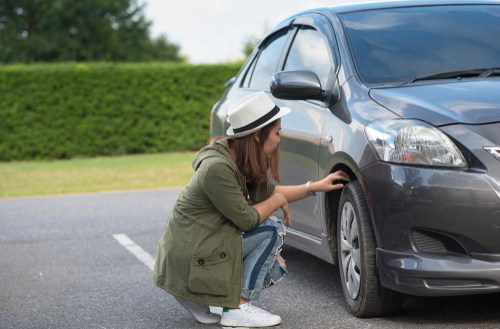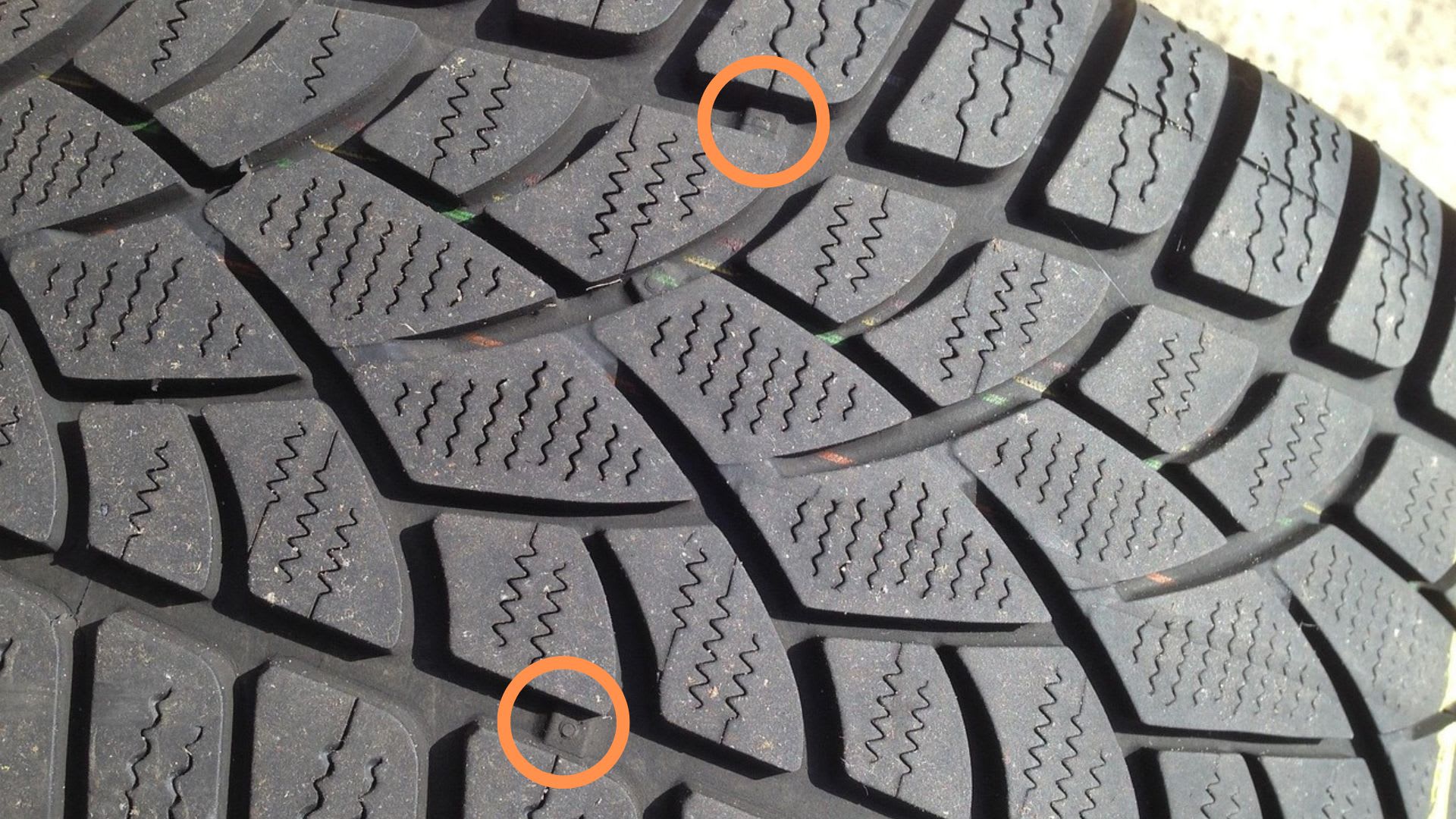Tire maintenance & safety
Best price guarantee
Tire replacement coverage
24/7 roadside assistance
Easy returns
How to Check Tire Tread Depth with a Coin

Maintaining proper tire tread depth ensures a confident and comfortable driving experience. Checking your tire tread regularly can help you identify when to replace tires, preventing accidents and costly repairs.
The best part is that measuring tire tread depth doesn't require expensive tools or a trip to the mechanic. With a few simple techniques, you can easily assess your tire's condition at home.
In this article, we'll explore the importance of monitoring tire tread depth and provide step-by-step instructions on how to check your tires using a coin. By the end, you'll be equipped with the knowledge to keep your vehicle running with a solid grip and control.
Why Check Tire Tread Depth?
Tire tread depth plays a crucial role in maintaining traction and control on the road. As tires wear down, their ability to grip the surface diminishes, especially in wet or slippery conditions. Shallow tread depths can lead to hydroplaning, longer braking distances, and reduced handling capabilities—all of which increase the risk of getting the vehicle out of control.
Regularly measuring your tire tread depth allows you to monitor wear patterns and identify potential issues before they become severe. Uneven wear, for example, may indicate improper tire inflation, wheel misalignment, or suspension problems. By catching these issues early, you can take corrective action and extend the life of your tires.
Most states have legal minimum tread depth requirements, typically around 2/32 of an inch. Driving with tires below this threshold not only compromises your safety but can also result in fines and legal consequences. Therefore, checking your tire tread depth regularly ensures that you remain compliant with these regulations and avoid unnecessary risks.
How to Check Tire Tread Depth with a Coin
Using a coin to measure tire tread depth is a simple, accessible method that every vehicle owner can perform. This technique allows you to quickly assess the tire’s tread available for use without the need for specialized tools, making it an ideal solution for those who value convenience and cost savings.
To check your tire tread depth with a coin, please follow these steps:
Step 1: The Penny Test
The penny test is a quick way to determine if your tires have reached the legal wear limit of 2/32 of an inch. Here's how to perform it:
- Take a penny and insert it into a tire tread groove with Lincoln's head facing down.
- Observe how much of Lincoln's head is visible above the tread.
- If you can see all of Lincoln's head, your tread depth is below 2/32 of an inch, indicating it's time to replace the tire.
- If part of Lincoln's head is obscured by the tread, your tires still have some life left in them.
Step 2: The Quarter Test
For a more conservative assessment, use a quarter to measure deeper tread levels:
- Insert a quarter into the tread groove with Washington's head facing down.
- Check if the tread touches Washington's head.
- If the tread reaches Washington's head, you have at least 4/32 of an inch remaining—a decent tread depth for most driving conditions.
- If you can see space above Washington's head, consider planning for a tire replacement soon.
Step 3: Using a Tread Depth Gauge
While coin tests provide a quick estimate, a tire tread depth gauge offers precise measurements:
- Purchase a simple graduated probe gauge from an auto parts store or online retailer.
- Insert the probe into multiple tread grooves across the tire, checking for even wear.
- Read the measurements provided in both 32nds of an inch and millimeters.
- Aim for tread depths above 4/32 of an inch for optimal performance and ride control.
- Replace tires once they reach 2/32 of an inch to ensure legal compliance.
Step 4: Inspect Tire Tread Wear Indicators

Most modern tires feature built-in tread wear indicators for added convenience:
- Look for small, raised bars at the bottom of the tire's main grooves.
- Check if these bars are flush with the surrounding tread surface.
- If the wear bars are level with the tread, it means the tire has worn down to 2/32 of an inch and needs replacement.
- If the tread is still above the wear bars, your tires have some life remaining.
Remember to inspect all four tires, as wear patterns may vary between the front and rear axles or even from one side of the vehicle to the other.
Tips on Maintaining Tire Tread
In addition to regular tread depth checks, there are several ways to maximize tire life and ensure even wear:
1. Regular Inspections
- Conduct monthly checks to monitor tread depth and overall tire condition.
- Early detection of uneven wear can prevent costly repairs and ensure better vehicle performance.
2. Timely Tire Rotations
- Rotate your tires every 5,000 to 7,000 miles to promote even tread wear.
- Proper rotation extends tire life and enhances performance.
3. Maintain Proper Tire Inflation
- Check tire pressure monthly and adjust as needed, referring to your vehicle's recommended settings.
- Underinflation can cause rapid wear on the tire shoulders, while overinflation leads to faster wear in the center.
4. Address Suspension and Alignment Issues
- Have your vehicle's suspension and alignment inspected annually or if you notice uneven tire wear.
- Correcting misalignment or worn suspension components can significantly improve tire life and handling.
By incorporating these tire maintenance practices and regularly checking your tread depth using the coin test or a gauge, you can ensure your vehicle remains safe, efficient, and road-ready for miles to come. Take control of your tire health today and enjoy the peace of mind that comes with proper tire care.
Tips on Maintaining Tire Tread
Ensuring your tire tread remains in good condition involves adopting consistent maintenance practices. This proactive approach not only extends tire life but also enhances overall vehicle performance, providing peace of mind on every journey.
1. Ensure Consistent Monitoring
Schedule regular checks to assess the condition of your tire tread. Look for any signs of irregular wear that could signal issues with tire balance or vehicle alignment. By catching these problems early, you can take corrective measures to maintain optimal tire function and prevent unnecessary expenses. Additionally, regular inspections allow you to clear any debris lodged in the tread, preventing potential tire damage.
2. Practice Strategic Tire Rotations
To achieve balanced wear, rotate your tires in a pattern suitable for your vehicle type at intervals recommended by your vehicle manufacturer. This practice distributes wear evenly across all tires, improving handling and extending tire longevity. Rotating tires according to the manufacturer's guidance helps maintain even tread wear across all tires, supporting a smoother ride and enhanced performance.
3. Maintain Optimal Inflation Levels
Ensure your tires are inflated to the pressures specified in your vehicle's manual, as proper inflation significantly impacts tread longevity and driving efficiency. Under-inflation can lead to excessive wear on the tire edges, while over-inflation may cause central tread wear. Regular pressure checks, adjusted for temperature changes, can improve fuel economy and prolong tire life.
4. Consider Addressing Vehicle Dynamics
It's essential to ensure your vehicle's alignment and suspension systems are in proper working order to prevent uneven tire wear. Regular checks, particularly after experiencing road impacts, protect your tires and enhance vehicle stability. Proper alignment and suspension maintenance are crucial for achieving uniform tread wear, thus preserving tire quality and ensuring a confident driving experience.
By mastering these tire tread depth-checking techniques and incorporating regular maintenance practices, you can ensure your vehicle delivers optimal performance and remains in control on the road.
At SimpleTire, we understand the importance of tire health and are committed to providing you with the knowledge needed to make informed decisions. If you want to buy the best tires for your vehicle online, let our helpful agents assist you in choosing the right one!
Ready to find the perfect tires?
Search By
